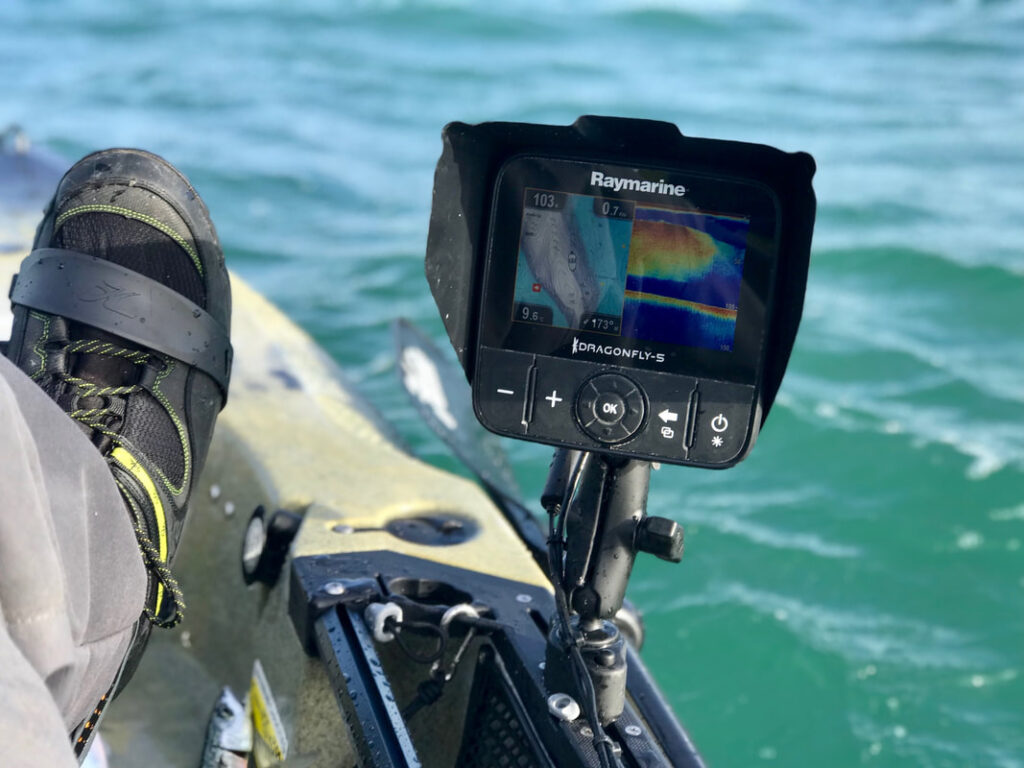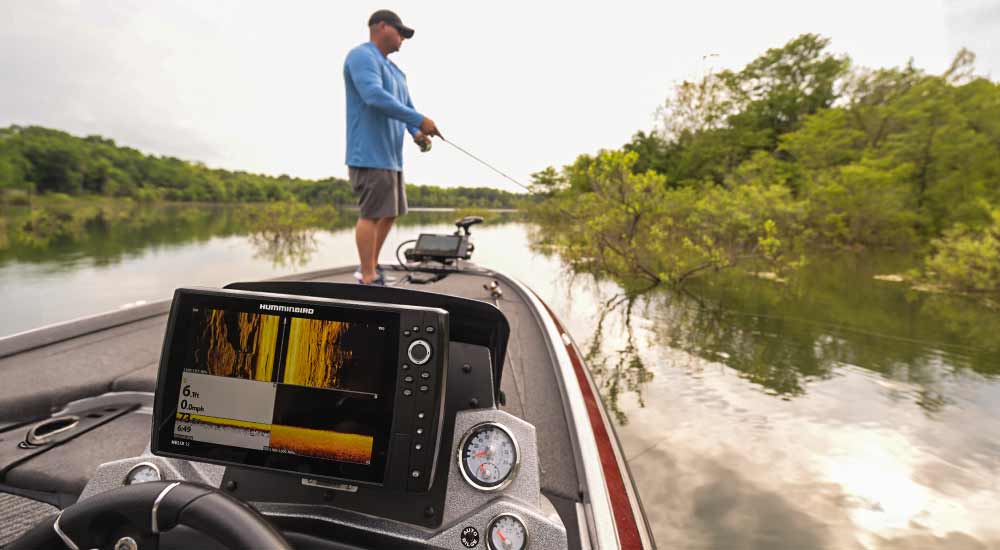Top 4 Best Fish Finders in 2025
Best fish finder technology has become an essential part of serious angling. No longer do you see fish; now, you know the water and what lies beneath your boat. Whatever kind of fish you are targeting, whether saltwater or freshwater, big lakes or small rivers, a quality unit will make locating structure, bait, and fish a lot more efficient.
Comparison Table: Best Fish Finders in 2025
Model | Display Type | Max Depth | Resolution | Features | Price |
Garmin Striker Vivid 7cv | LCD | 750 Feet | 800 x 480 pixels | CHIRP, ClearVü, GPS, Wireless | |
Humminbird PiranhaMAX 4 | LCD | 600 Feet | 480 x 272 pixels | Dual Beam Sonar | |
Garmin Striker Plus 4 | QSVGA | 66 Feet (20 m) | 800 x 480 pixels | GPS, Bluetooth, Quickdraw | |
iBobber Wireless Fish Finder | LCD | 135 Feet | Depends on Phone | Bluetooth, App-Based, Castable |
If you’re looking for value, the best fish finder for the money usually strikes a perfect balance between price and performance. Such models typically feature GPS, CHIRP sonar, and even a color display, providing accurate depth readings and target visibility without adding to your wallet. Many intermediate anglers turn to them as one of their go-to rods, thanks to their professional features, without the concern of overspending.

For those just starting or fishing casually, the best budget fish finder or the best cheap fish finder can still deliver useful sonar performance. They do not offer high-end imaging or touchscreen capacity; however, some models in this line are highly recommended for their ease of use, durability, and battery savings, particularly when used with kayaks or jon boats.
Garmin Striker Vivid 7cv with GT20-TM Transducer
If you’re looking for a fish finder that delivers clarity, accuracy, and performance, the Garmin Striker Vivid 7cv is a dependable companion on the water. The product is designed to satisfy anglers who desire something beyond the typical sonar; therefore, the device is integrated with vivid scanning technology, high-sensitivity real-time mapping, and GPS features. The 7-inch colour display, combined with strong CHIRP sonar and ClearVu scanning, enables fishers to find fish and navigate the water with confidence. This unit enhances the accuracy and ease of fishing, regardless of where you fish, whether on lakes or coastal waters.
Garmin Striker Vivid 7cv
Key Features
- ✅ Screen Size: 7 Inches
- ✅ Display Type: LCD
- ✅ Item Weight: 4.4 Pounds
- ✅ Display Features: Wireless
- ✅ Display Resolution: 800 x 480 pixels
Pros
Cons
Why We Chose It
Our experience with the Garmin Striker Vivid 7cv has been consistently positive across multiple uses. The sonar reads acutely and in detail, which can help in the easy discovery of fish and structure. The ClearVu scanning offers out-of-this-world clarity underwater. It is easy to install, and once installed, the unit performs accurately and steadily, even in sunlight. The screen remains clear and undistracted.
Its interface is also quite friendly and smoother compared to other models we use, making it easier to use even in real-life fishing situations. Nevertheless, the overall performance and functionality of such a fish finder are so good that despite the lack of a screen cover, a serious fisherman would want to use it.
Humminbird 410150-1 PiranhaMAX 4
If you’re after a no-fuss fish finder that still delivers sharp sonar performance, the Humminbird PiranhaMAX 4 is a solid choice. Its small and sleek design, easy operation, and straightforward underwater photography have made it an interesting product for people who want assurance of the quality performance of a device in a strong, portable body.
Whether you’re on a creek, river, or open lake, this unit brings you closer to the action clearly and assuredly without overcomplicating your setup.
Humminbird 410150-1
Key Features
- ✅ Screen Size: 4.3 Inches
- ✅ Display Type: LCD
- ✅ Item Weight: 2 Pounds
- ✅ Maximum Measuring Depth: 600 Feet
- ✅ Display Resolution: 480 × 272 pixels
Pros
Cons
Why We Chose It
Our experience with the Humminbird PiranhaMAX 4 has proven it to be a solid and reliable choice for essential sonar functionality. It is a simple unit that does what it claims to do, continually finding depth and underwater details. Installation was easy, even when it was used as an alternative to older models.
Its portability is its selling point, and it should be installed as a backup to a primary fishfinder. It is also well visible even in direct sunlight. Although it is worth mentioning that separate fuse housing and power compatibility are necessary, the overall build and performance quality helped make this a reliable component in our fishing arsenal.
Garmin Striker Plus 4 with Dual-Beam Transducer
Designed for anglers who require power in a compact package, the Garmin Striker Plus 4 provides reliable sonar imaging and intuitive navigation. It is rugged and paired with a well-trusted dual-beam sonar from Garmin, as well as an in-built GPS, making it a must-have for daily fishing. Exploring shallow rivers, cruising lakes, drilling through ice, or whatever, this unit provides all the capabilities required to find fish, lay marks, and trace the structure, all in a pocket-sized unit.
Garmin Striker Plus 4
Key Features
- ✅ Screen Size: 4.3 Inches
- ✅ Display Type: QSVGA
- ✅ Item Weight: 0.7 Pounds
- ✅ Maximum Measuring Depth: 20 Meters
- ✅ Display Resolution: 800 x 480 pixels
Pros
Cons
Why We Chose It
Our experience with the Garmin Striker Plus 4 has been highly rewarding, particularly in terms of ease of use and the reliability of its sonar feedback. It is a unit that is easy to install, and the interface, once powered on, is perceived to be intuitive.
The readings of depth are steady, and the fish detection is accurate enough to aid everything, from weekend voyages to full-day fishing trips. The built-in GPS unit is used for monitoring the path and stays clear and easy to understand, even in daylight. The unit is well-suited where it belongs, even when fitted to a kayak or a compact boat.
The most impressive feature during our utilization was the Quickdraw mapping. During fishing time, the real-time contour mapping system developed an in-depth display of the submerged terrain, creating a picture of it as we maneuvered over lakes and rivers.
A split-screen configuration allowed us to follow the sonar and chart simultaneously, enabling us to fish smarter and identify the best places to leave alone. The interface remained performant even on long sessions, and we had no trouble zooms and panning data.
iBobber Portable Wireless Bluetooth Fish Finder
The iBobber Portable Wireless Fish Finder is designed for anglers who need simplicity, mobility, and smart technology all in one compact device. It is suitable for use during shore fishing, kayaking, or casting off the dock, as it can easily transform your mobile device into a serious fish finder when connected via Bluetooth. Although it is small, it provides clean sonar feedback to help locate fish and structures with remarkable precision, making it a convenient solution for both weekend excursions and targeted search missions
iBobber Portable Wireless Fish Finder
Key Features
- ✅ Screen Size: 5 Inches
- ✅ Display Type: LCD
- ✅ Item Weight: 0.05 Grams
- ✅ Maximum Measuring Depth: 135 Feet
- ✅ Display Resolution: Depend on Phone
Pros
Cons
Why We Chose It
The fact is unique, as we have enjoyed using the iBobber Portable Fish Finder, particularly as shore fishers and kayak fishing enthusiasts who seek a basic wireless setup. It is easily connected to a smartphone via Bluetooth. It features a user-friendly app interface that provides sonar readings, displaying depth, structure, and even the water contour of the fish.
Although it is small enough to fit in a pocket, it provides helpful information, allowing us to discover the location of fish and drop-offs we could not see previously. It was easy to set up, and the floating design was great once you took it off a kayak or cast offshore.
In particular, the sonar also allows us to mark fish and distinguish between them by size, as color-coded signals and live information about depth are provided. Its visibility during the day and night was good, as it came with an inbuilt light that served as a good visual aid. The casting eyelet was solid and firm, even with rougher water.
The ability to map also allowed us to create a mental picture of new fishing grounds so that the next time we went, it would be simple to return to those areas where we had caught the most fish. The iBobber also had some potential as a lightweight solution for locating probable ice-fishing regions during the winter season.
Conclusion
Best fish finder units are no longer luxury gear—they’re essential tools for anglers who value precision, efficiency, and results. Whether it’s the depth of deep water or the murk of a structure-laden shallow, the appropriate device helps you see the difference in knowing how to fish smarter. Just decide on the type of fishing that reflects your style, such as a portable, castable, small-boat, or full-featured model, and you will eliminate the guesswork, spending more time where the fish are.
Whether it is the clarity of the sonar, the precision of the GPS, or portability, all these features directly affect your navigation success on the water. Purchasing a suitable fish finder not only makes fishing convenient; it’s about having every advantage.
When it comes to catching more fish and avoiding time wasted on guessing, it’s time to decide on the type of model that explains how and where you fish. The right choice will count on each future visit.
Things to Consider While Choosing a Fish Finder
Sonar Frequency and Type
Your finder locates fish and structures using sonar technology. Conventional 2D sounding serves most purposes, while CHIRP sounding emits multiple frequencies simultaneously, providing clearer images and a clearer separation of the distance to the water bottom, among other benefits. This is particularly beneficial in areas with deep or muddy water.
Display Quality and Size
The fish finder is as good as what you manage to see. Even mid-range models usually have high-resolution color displays now. Seek screens with anti-glare properties and user-friendly menus, which can enable one to interpret sonar feedback quickly in cases of bright daylight or nighttime fishing.
Fixed vs. Portable Units
Portability is an issue related to your fishing style. Fixed units are suitable for individuals who wish to have permanent installations on their boats. In the meantime, portable models or castable models are marvelous for flexible installations, which work perfectly well for those who operate kayaks, float tubes, or a variety of boats.
Built-in GPS and Mapping
GPS is not just about navigation but also about indicating productive places. GPS-integrated fish finders allow you to mark waypoints and your tracks, as well as save hotspots. Some models facilitate the simple plotting of charts, while others allow for the creation of entire lake or coastal maps, aiding in more detailed planning.
Power and Depth Capabilities
Just think of when you enjoy fishing. How deep the water is. The deeper the waters, the higher the wattage and the more sensitive the sonar. The shallow ones do not require that much power, yet accuracy is essential, especially when you aim toward fish near the structure.
Battery and Power Source
For portable and castable models, battery life must be verified. An effective fish finder must be able to function for up to 6-10 hours after receiving a full charge. In mounted units, you will need to consider the power draw and adaptability to your boat’s system.

